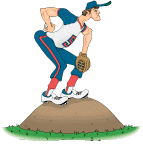Joe McFarland
Coaching Pitchers

Many times coaches are guilty of throwing pitchers entirely too much,
taking a chance of seriously hurting a pitcher's arm. Other times
coaches are guilty of not working their pitchers enough, which leads
to underdevelopment.
Both patterns hurt their chance of becoming the best pitchers they can
be. Coaches tend to overthrow their best pitchers, trying to win, and
under throw the rest of the staff.
By setting up a schedule including all pitchers and adhering to it,
both types of pitchers will benefit and, as a result, so will the
team.
Note: Throwing does not necessarily mean pitching in a game. It
includes bullpen work, scrimmage games, and long-toss workouts. Long
toss There are many definitions of the long toss, and many views on
what is supposed to be accomplished by the long toss.
All the same, here's a description of a standard long-toss workout.
The pitchers start 50 feet apart and gradually back up to a distance
just beyond what they can throw in the air. After 10 throws at the
maximum distance, the pitchers work their way back. Forty to 50 throws
are usually adequate to stretch the arm. However, in the off-season,
when a pitcher is trying to develop arm strength, more repetitions are
required-up to 100-with one third of those being at the maximum
distance.
Unless they are injured, pitchers should long toss at least every other
day. In-season pitchers may want to cut down the number of long tosses.
Off-season, pitchers should long toss only every other day and increase
the repetitions to develop arm strength. Long-tossing, more than
anything else pitchers do, increases velocity. It also shortens their
recovery time.
Long tossing the day after pitching a game stretches out the arm and
helps with blood circulation in the arm. Number of pitches The number
of pitches pitchers throw in a game, a scrimmage game, or the bull
pen should be carefully monitored by the coach.
Number of pitches: (Game) As a general rule, 15 pitches per
inning times the number of innings in a regulation game is a good
cutoff point. (Example: 15 pitches x 7 innings = 105 pitches, which
should be the cutoff point for high school pitchers.
For college pitchers, 135 pitches would be the cutoff point. When a
pitcher has reached this cutoff number, he or she should be removed
to avoid overuse and possible injury. By keeping track of pitches,
the coach can look ahead and have a reliever ready to go in when
needed.
Obviously, a few pitches above the cutoff point probably will not
harm the pitcher, if, for example, the pitcher needs only one out
to finish the game. It is estimated that 80 percent of all arm
injuries occur after these cutoff points, so it is very important
to monitor the number of pitches each pitcher has thrown.
Number of pitches: (Bull pen) It is very important to monitor
the number of pitches each pitcher throws in the bull pen to ensure
that there is no overuse and that the pitcher will be effective when
called upon.
Relief pitchers: Coaches who use their bull pen effectively
are most often the most successful coaches.
A middle- or long-relief pitcher should try to stay on an every other
day plan. It is hoped that the coach can work the relief pitcher's
bull pen to coincide with the schedule. Short relievers can throw
on a schedule of two days on, one day off, because they seldom throw
many pitches. Should the short reliever happen to throw an excessive
number of pitches one day, then he or she should not throw in the
bull pen or in a game the following day.
When a relief pitcher throws an excessive number of pitches preparing
to go into a ballgame, the number of these pitches should be monitored.
A relief pitcher might throw only 15 pitches in a game, but he might
have been warming up for five innings if the starting pitcher was
constantly in trouble.
Many coaches ignore the warm-up pitches and count only the actual
game pitches when deciding whether that pitcher is available the
next day. By monitoring all bull-pen work, the coach would realize
that the relief pitcher threw 75 pitches in the bull pen plus 15
pitches in the game for a total of 90 pitches. This pitcher should
have a day off the following day, not only to prevent overuse but
to ensure effectiveness.
Human Kinetics Web Site